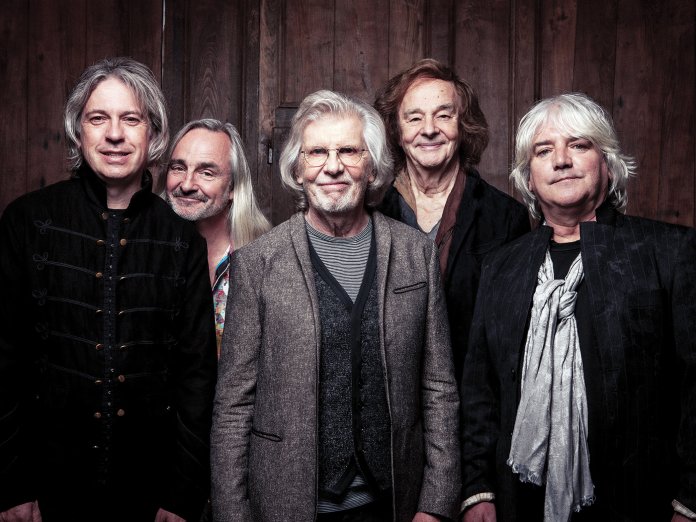The Zombies were outliers even in the futuristic surge of the ’60s. Rod Argent wrote their debut, smash single “She’s Not There”, after digging up John Lee Hooker’s “No One Told Me” from a pile of blues records for his lyrical spark, but drew its unusual chords from Bryan Hyland’s Bach-based “Sealed With A Kiss”. Its central conceit, meanwhile, conjuring a girl by her absence, was worthy of American songbook masters such as the Gershwins.
The other hallowed achievement of their four-year professional run, Odessey And Oracle (1968), was dressed up in a psychedelic sleeve and title, but occupied its own realm of quiet, inward thoughts and chamber arrangements. The haunted pastoral dream of bassist Chris White’s “Beechwood Park” came closest to the season’s altered states, as Argent’s spare, hook-laden, suggestively titled “Time Of The Season” attached itself to the times to huge US success. Though they had been enthused by rock’n’roll, the closest their keystone work got to its earthy rush was the ecstatic chorus harmonies of “Care Of Cell 44”, topped by Colin Blunstone’s sweet, yearning voice, itself innocent and pure in the late ’60s tumult. Their essential self was soft and refl ective, touching on older songwriting verities.
Famously splitting a year before “Time Of The Season” became their second standard, they stubbornly refused to reform to exploit it. Blunstone briefly joined an insurance firm before continuing his singing career, and Argent’s eponymous band entered the ’70s with the harder-hitting, White co-written “Hold Your Head Up”. Belying their name, they buried The Zombies, one brief, Argent-less reunion apart, for 36 years. “I always felt there’s been a bit of mystery to The Zombies,” Blunstone believes. “I don’t quite understand our career path. Rod and I always concentrated on the future, so when the two of us got together in 1999, we didn’t call ourselves The Zombies, and hardly played any Zombies tracks. We thought that everything had been forgotten. It was a wonderful surprise to realise how fondly the Zombies repertoire was remembered.”
After resuming the Zombies name in 2004, White and original drummer Hugh Grundy occasionally return for Odessey And Oracle gigs, but Argent and Blunstone have been the constants during a 21st century which has enjoyed twice as many Zombies albums as the 20th. This fourth reunion record was taped mainly live, at something like ’60s pace.
Confirming their philosophy of looking forward, Different Game rarely recalls their old sound, instead suggesting more intriguing ’70s comparisons, most especially Steely Dan. “Run Away”’s jazzy chords, hazy, wasted mood and lush West Coast sophistication (conjured in Argent’s home studio in a Hampshire village) sees Blunstone’s usual breathy loveliness grow more sardonic and desperate, hinting at both Donald Fagen and Michael McDonald. “Steely Dan are a great favourite of all the band,” Blunstone acknowledges, “and there has always been a jazz element to Zombies music. If you listen to the keyboard solo in ‘She’s Not There’, it’s very unusual for the time. Rod has always been incredibly interested in jazz, and that goes for the whole band.”
The title track, with an organ solo reminiscent of “A Whiter Shade Of Pale” (and “Beechwood Park”) is the only track to directly address The Zombies’ generation, with Blunstone’s still pure but inevitably older voice finding elegiac urgency untouched in his youth. Argent, who wrote all but one song here, was inspired, Blunstone says, by watching a documentary on “a classic rock star from a very famous band”. “I know you’re feeling helpless”, Blunstone sympathises. “Can’t seem to find that door to open any more/God knows it was crazy/Now seems such a cold and distant shore/You just want to feel the same old thrill…” You can insert your own ageing hedonist here, raging for someone to blame as his youth and power ebbs. The Zombies’ potently plunging chords and sad-eyed sympathy stay undimmed.
“Got To Move On” indulges in nostalgia, with Argent digging out harmonica, as heard on “She’s Not There”, for its blue-eyed R&B. “I Want To Fly”, first attempted on 2004’s unloved comeback under the Zombies name, As Far As I Can See…, recalls their essential strengths. Orchestration is subtler than the original, finding more shadows as Blunstone emphasises each syllable along with percussive, pressing strings. He’s inhabiting the persona of a lonely man, dreaming perhaps of transcendence, perhaps cliff top suicide.
While you’ll find little direct trace of Odessey And Oracle here, or of course White’s distinctive songwriting contributions, Blunstone’s heartfelt interpretation of Argent’s classicist craft does, though, endure.



